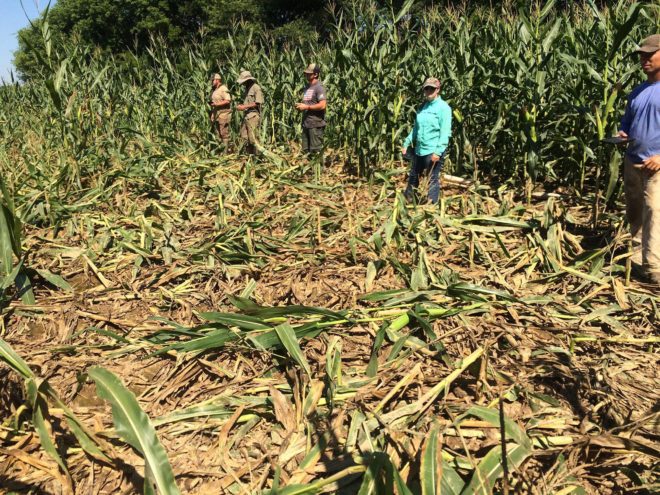STARKVILLE, Miss. — Rooting and wallowing by wild hogs cause extensive land and crop damage, which can be stopped only by getting rid of the invasive animals.
Bill Hamrick, a wildlife associate with the Mississippi State University Extension Service, said wild hogs use their snouts to turn over soil as they search for food.
“I heard someone say that if it has a calorie and they can get their mouth around it, hogs will eat it,” Hamrick said. “Wild hogs are a generalist species. They eat whatever they can find year-round.”
Hogs root for worms, insects, small animals, tubers, roots and bulbs in the soil. Fall brings acorns and nuts as food sources. Winter offers berries, invertebrates that surface on warm days and anything found living under fallen logs. Tender, green shoots are available in the spring. Grapes and fruits ripen in the summer. Crops are a special treat for hogs in all seasons.
“There are many instances when farmers first plant corn or soybeans, and hogs will go down the rows that night and vacuum up the planted seeds,” Hamrick said. “I’ve heard of some farmers who had to replant three times.”
Growing corn presents other feeding opportunities. Hogs will sometimes eat green ears, but they especially like mature corn, and they can cause extensive losses eating dried corn that is awaiting harvest. Hogs also use mature cornfields as travel routes, safely moving under cover of the canopy.
“You can drive around a cornfield on all four sides and it looks beautiful, but you get on top of it and there may be an area the size of a football field that hogs have destroyed,” Hamrick said.
Once rice and soybeans begin to mature, these crops become favorite targets of roaming hogs.
“They don’t just eat the rice,” he said. “It’s a grass, so they roll over it and mat it down. They also root up the levees in the rice fields that hold water. They’re a very destructive species.”
In south Mississippi, peanut crops often suffer damage and yield losses when hogs move into a field to eat. Even cotton provides a meal for wild hogs when the bolls are young and green.
In addition to damaging fields and crops, hogs can destroy polypipe irrigation systems. Rooting and wallowing also damage roads.
Hogs rub on pine timber and root around trees, causing erosion around roots and making the trees more susceptible to wind damage. Hogs damage seedlings and young trees with their rooting, and they sometimes dig up saplings to eat the taproots. Rooting often dislodges hardwood seedlings, negatively affecting forest regeneration.
“Their sense of smell enables them to find acorns as well as deer can find them, and this leaves fewer new hardwood seedlings to emerge,” Hamrick said.
Hogs have a history of destroying yards looking for grubs, earthworms and other invertebrates under the sod. Extensive rooting has been known to destroy irrigation and sprinkler systems installed at houses and businesses.
Hunters encounter damage and losses caused by wild hog activities, as well.
“Some hunters find their duck holes destroyed by hogs,” Hamrick said. “Others plant forages like wheat and cowpeas to attract deer, and they find that hogs go in and decimate the crop. Many times, hogs root up a food plot, as the freshly tilled, loose soil is a good place to find invertebrates.”
Bronson Strickland, Extension wildlife biologist and wildlife management specialist, said landowners should look for signs of wild hogs rather than waiting for damage to appear. In addition to wallows and rooted-up ground, telltale signs are trees or poles covered in mud on the bottom 2 to 3 feet where hogs rub against them.
“If I have a land resource that can be damaged badly by pigs, then I’m going to be proactive rather than reactive,” Strickland said. “Use trail cameras, and ride through the property looking for signs of hogs, because the quicker you start erecting traps, the better off you’ll be.”
When wild hogs are detected on land, the first thing to do is find out where they are coming from, he said. This information determines where to set traps, but that is not the end of the matter.
“When pigs come onto your property, they’re coming from someone else’s property, so I’d develop a relationship with my neighbor so we can work on this together,” Strickland said. “No property is an island.”
Hunting hogs has a limited effect on reducing numbers because the animals breed prolifically. Fencing is economically feasible only in certain situations. Research has found that trapping and exterminating the captured hogs is the best long-term solution.
“I have heard from credible sources that when land is overrun with hogs, landowners have been unable to lease it for hunting,” Strickland said.
Information provided by the Mississippi State University Extension Service.




